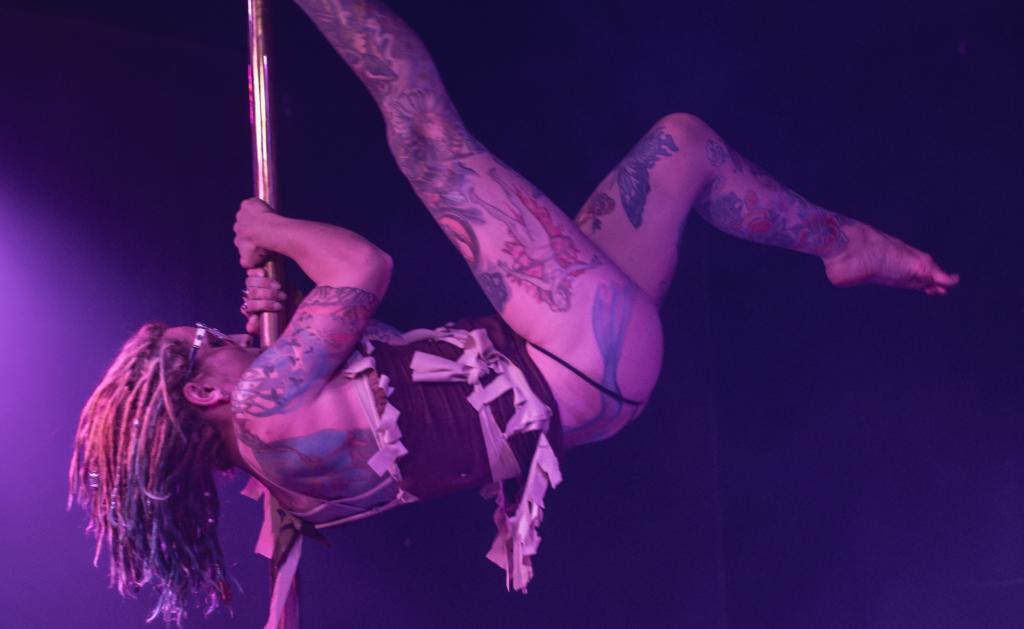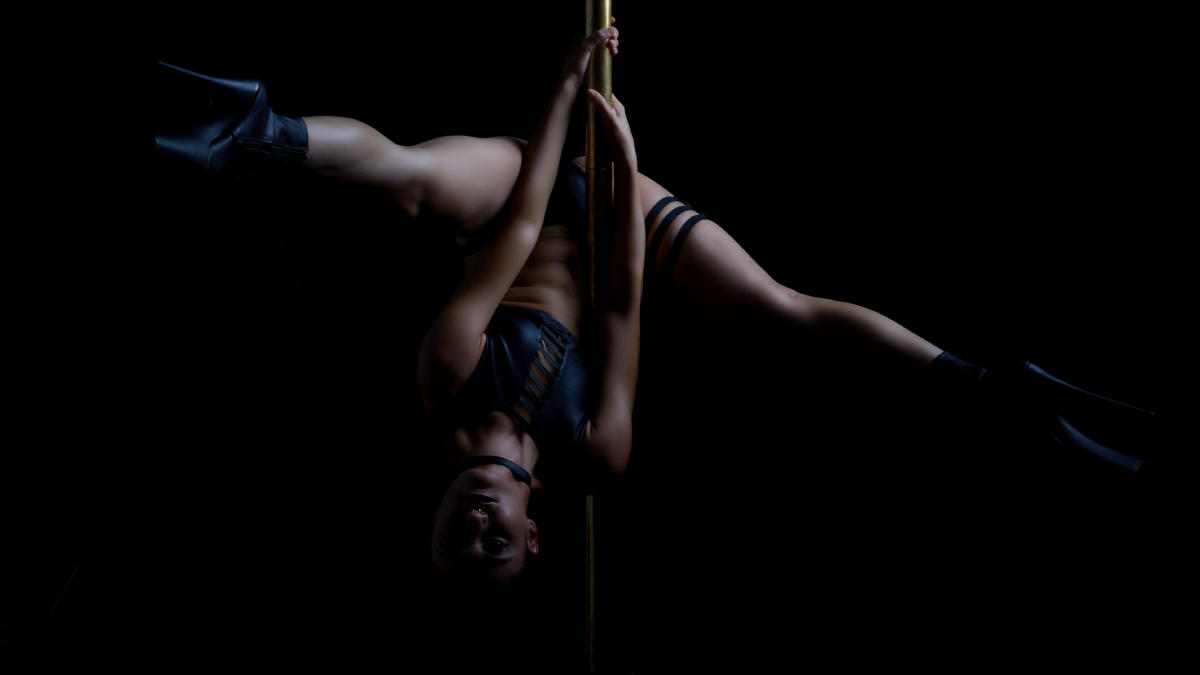A pole, six-inch heels, and a massive pile of cash.
Think of “stripper money,” and there’s an image of a nearly naked woman rolling around in an entire month’s rent. And to a degree, that image is accurate.
But what few outside the industry realize is exactly how much of that cash the dancer gets to keep or what they endure to make it.
“Many are surprised to learn that exotic dancers not only don’t get paid an hourly wage, but just how much we pay to work,” says Mistress Lilith, a Philadelphia stripper, dominatrix and activist. She says the rate to rent the stage in Philadelphia may range between $20 to $80 per shift, with no guarantee that they’ll make anything. “We also pay the DJs, the house moms. Depending on the club, we may also tip out hosts or security staff, on top of cuts that are taken from our sales.”

Before dancers won a lawsuit against it in 2018, the Penthouse Club in Philadelphia required dancers to tip out nearly the entire venue staff, including the valet … even if they didn’t have a car. The court ruled it had been improperly labeling dancers as independent contractors in order to cheat them out of wages. Similarly, according to Mistress Lilith, dancers recently won a class action lawsuit against another local club, yet many venues continue the same exploitative practices, often using worker classification as an excuse.
While exotic entertainment is the primary reason for patrons to attend a strip club, many dancers say they’re not treated like integral parts of the business’s success. It’s unclear what position they hold at all.
Since they are given no set wage and do not receive employment benefits, it would imply dancers are independent contractors. Yet clubs also control them like employees, by setting requirements on how many hours they work and when, saddling dancers with expensive costume requirements, and even dictating whether they can chew gum or have a cell phone on the club floor. Violations of those rules can result in punitive fines.
Mistress Lilith, who has worked in nine clubs in and around Philly since 2014, says these exploitative business practices “began in the late 80s, early 90s” when so-called Gentlemen’s Clubs started using “the current contractor model. Before this, dancers were paid, or at least did not pay to work.”
But the solution is more complicated than simply changing employment status.
Whether strippers should be classified as employees or independent contractors is one of the most contentious issues in the industry. Some states, like California, have changed the way employees are defined, impacting everyone from strippers to barbers, journalists and dog walkers. The aim was to ensure businesses were responsible for payroll taxes and workers received benefits like insurance, vacation and right to unionize. But when dancers become employees, strip clubs started taking a bigger cut of their wages, demanding exclusivity contracts, and even taking away the freedom to decline patrons’ requests for private dances.

And battling for workers’ rights isn’t the only daunting part of the job.
“Verbal, physical and sexual harassment and assault by customers and management happened regularly at every club,” says Mistress Lilith. “One of the worst periods was when I was dancing in South Philly during the election of Trump, I dealt with racism a lot as a Latina.
“The first time I spoke out about workers’ rights was after I had an experience at a club where I was assaulted and then fired,” she says. “The customer even got a refund after the incident. I was so traumatized that I didn’t return to work anywhere for a month.”
While experiences vary widely, several of the dancers to whom PW spoke for this piece had terrifying on-the-job stories.
“It’s a madhouse on a weekend night and for strippers who haven’t built up a tough skin yet for self-preservation, (they) walk out with trauma almost every night,” says Darlina, a stripper who lives in Manayunk and has worked at three area clubs so far. She says customers can be entitled and aggressive and that, in her experience, “security is only in it for the occasional fist fight scenes, drama and free showings.
“The first time I spoke out about workers’ rights was after I had an experience at a club where I was assaulted and then fired. The customer even got a refund after the incident. I was so traumatized that I didn’t return to work anywhere for a month.”
– Local stripper Mistress Lilith
“You certainly can’t find them checking up on you when you’re stuck doing a VIP dance for an aggressive customer who thinks they are getting third base for $250,” says the dancer, who turned to strip clubs as a way to finance her way through college. She also says security did nothing when a customer slapped her while she was on stage, leaving a welt.
Darlina says the club managers often don’t care about dancer safety and that when asked for support, “they respond by either threatening termination or suggesting that a dancer find a different place to work. They typically are not open for recommendations.”
Her managers might partially be right, in that a stripper could have a more positive experience at another club. Several dancers cited wildly varying levels of respect and accountability from venue to venue.
“I really feel safe where I work, but…they are not perfect,” says AN, who has been involved in burlesque and club stripping for eight years on and off. She says she’s been able to assert her rights to management, but many dancers can’t navigate the system as easily. Her club is one of only a few where dancers have access to their contracts, but she says it “clearly only functions to protect the club from lawsuits over labor rights.
“From what I hear, some other clubs in Philly exploit girls for money at every chance they get with illegal fees and forced sharing of tips. Security at another club told a dancer friend he wouldn’t hear her scream for help unless she tipped him $50.”
Agony, an ex-stripper who worked at multiple clubs in Canada, has had mixed experiences as well. She says, “They were overall OK, but I’d say my best experiences were in the Ottawa clubs: the managers were pretty much absent, the schedule was VERY flexible (when there was one at all) and the girls had almost complete freedom over what they could wear or do on stage.”
“From what I hear, some other clubs in Philly exploit girls for money at every chance they get with illegal fees and forced sharing of tips. Security at another club told a dancer friend he wouldn’t hear her scream for help unless she tipped him $50.”
— Philly exotic dancer known only as AN
Even in that comparatively idyllic context, she was troubled by the common unsafe practice of full nude lap dances and the difficulty arising from sharing workspace with “the abundance of girls doing extras.”
She also added, “I started having body dysmorphia while working in Montréal because managers would constantly tell me I was too fat or not pretty enough.”
Agony’s experience with body-shaming is not uncommon, and along with racism and colorism, can present a huge boundary in dancers’ options for where they can work. Switching to a more supportive club may not be an option for everyone.
“Most clubs also have very discriminatory hiring practices,” says Mistress Lilith, “The type of dancer that is guaranteed to be hired at most clubs regardless of experience or skills are young, thin, conventionally presenting white women. Dancers of color, different body types and presentations, and openly queer or trans individuals will have fewer options.”
“The only real rule in a strip club is ‘don’t fuck with the money,’” confirms long-time security staffer Chris. He’s worked at clubs in multiple states and says, “Anything sufficiently profitable will generally be tolerated as long as plausible deniability can be maintained. Essentially, the entire business model is to create the highest-energy, least-rational environment possible, then extract as much cash as possible from the compromised customers without the whole thing tipping over and blowing up. Maintaining the balance is largely security’s job.”
Given this is the reality, why do so many people still gravitate toward the industry? Most dancers cite the flexibility of hours and potential to make a lot more money than they would at a less-stigmatized job.
“As a bartender in Philly, I was often objectified by inappropriate customers while being trapped behind the bar, and as an employee I had to be nice or lose my job,” says AN, who has now worked at two clubs and is largely satisfied with her career as a stripper. “I didn’t want to be forced to grit through bad behavior in the name of customer service anymore, and I wanted to be compensated for…tolerating this behavior that I encounter from men regardless of where I work.
“I wanted control of my life, my money, my autonomy, and my schedule. This was the best way to achieve financial freedom as I work through my student debt,” she says.

AN says the labor of stripping is a lot more than working the pole and the stage. She describes the job as “professional companionship, image/brand management and advertising, financial planning and accounting,” and adds, “We do everything that other entrepreneurs do (but with none of the credit!)”
“The job is both physically and mentally demanding,” she says, but maintains, “My work has also led me into my healthiest self so far. … Learning to establish and maintain healthy boundaries with my labor has helped me grow with the job instead of being depleted from it. The benefits of making my own schedule and being my own boss has been worth the trade of time and labor. However, not all clubs make it possible for independent contractors to exercise these rights, and I have dealt with pushback in asserting my own.”
Across the nation, dancers are fighting for their right to a safe working environment and the validity of their work.
Bloomberg Law found 406 lawsuits were filed by dancers against clubs since 2005 specifically about employment misclassification, with nearly two-thirds filed in the last five years.
In addition to these suits, some local governments are crafting laws explicitly to protect strippers. As reported by the Star Tribune, adult businesses in Minneapolis will now, “be required to give workers copies of their contracts, post rules for (customer) conduct and workers’ rights, and prohibit retaliation against workers who report violations. Managers and owners will be prohibited from taking tips from entertainers, and entertainers will be provided security escorts when leaving after a shift.”
The movement for dancers’ rights is not new, though it was galvanized after the passage of FOSTA-SESTA in 2018. FOSTA-SESTA are laws meant to combat sex trafficking that experts say have only made the issue worse and made life far more difficult and dangerous for sex workers, including those in legal jobs like strippers, nude models and porn performers.
Their work made even harder and more dangerous, dancers are fighting back, and their concerns are finally being brought by public awareness. The New York Times ran a lengthy profile on the dancers battling for change in the industry,
Huffington Post reported on the use of old-school unionizing efforts by dancers, and Jennifer Lopez’s recent flick “Hustlers” addressed many of these issues. This visibility is hopefully helping bring attention to strippers’ organization efforts and empowering others to join.
“There is very little representation of us in the media, politics, or even popular culture. We’re constantly stereotyped and stigmatized,” says Mistress Lilith, who has been an outspoken advocate for strippers’ and sex workers’ rights. She acknowledges not all dancers can or want to get involved in activism and those who do often experience backlash. She says dancers risk losing their jobs and being blacklisted, while being outed as a dancer may mean loss of family and community support or inability to be hired in another career. Some who dared to speak out received death threats. “This makes the process of speaking out and advocating for ourselves not only difficult, but risky. I realized I had to start though, it’s the only way to change things.
“Without us, these clubs have nothing. If we work together we can change the clubs from the inside in the meantime, while creating the vision for the types of clubs we want to see in the future,” says Mistress Lilith, who has been sharing information with dancers and the general public, speaking out at events, and even creating diverse, inclusive pop-up strips clubs that are run by dancers. One day she dreams to own her own club that will be run ethically.
Besides ensuring labor rights protections, what other changes are wanted by activists? AN has a whole list. She says dancers need resources for their taxes, managing emotional labor and mental health, escaping domestic and sexual abuse, plus club-wide education about sex trafficking, dancers’ rights and local prostitution laws.
“Did you know in some states you can get a ticket for prostitution for taking your shoes off in a champagne court? Dancers need to know the laws and resources state to state that pertain to them,” she said.
She also says dancers need “legal protection and resources for sexual misconduct,” and adds, “police are not to be trusted and need to go through sensitivity and consent training, but that can’t happen until we address the archaic laws around full service sex work and stripping.”
Some of these changes will require massive social and legal shifts, but AN also mentions some of the smaller battles that dancers can win, like getting paid to do promotion for the club. “The club needs you. It’s not a compliment to be chosen to model for them,” she says, “You should be compensated for your time and image because attention and flattery don’t pay your bills. Charge for everything. Don’t work for free.”





